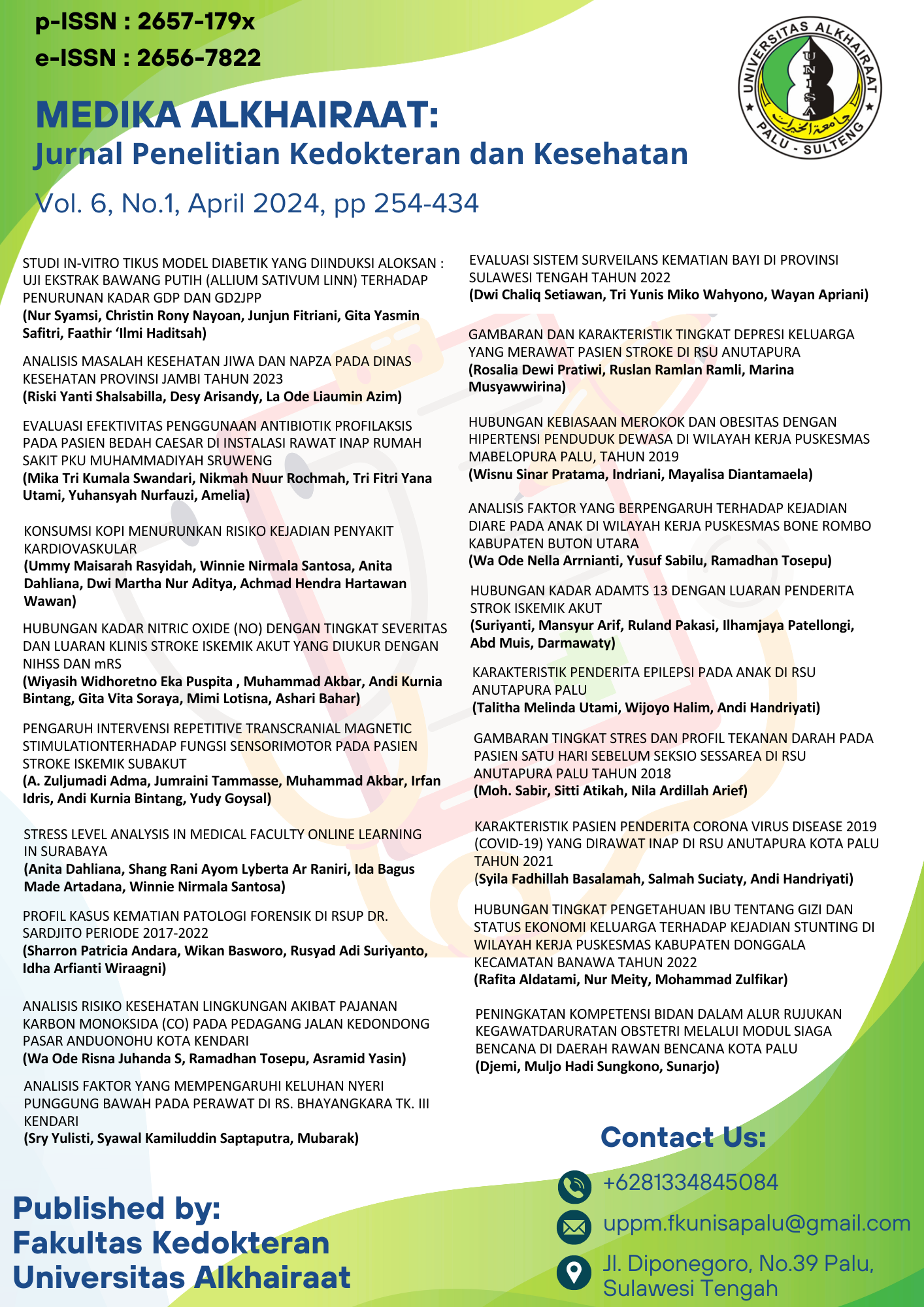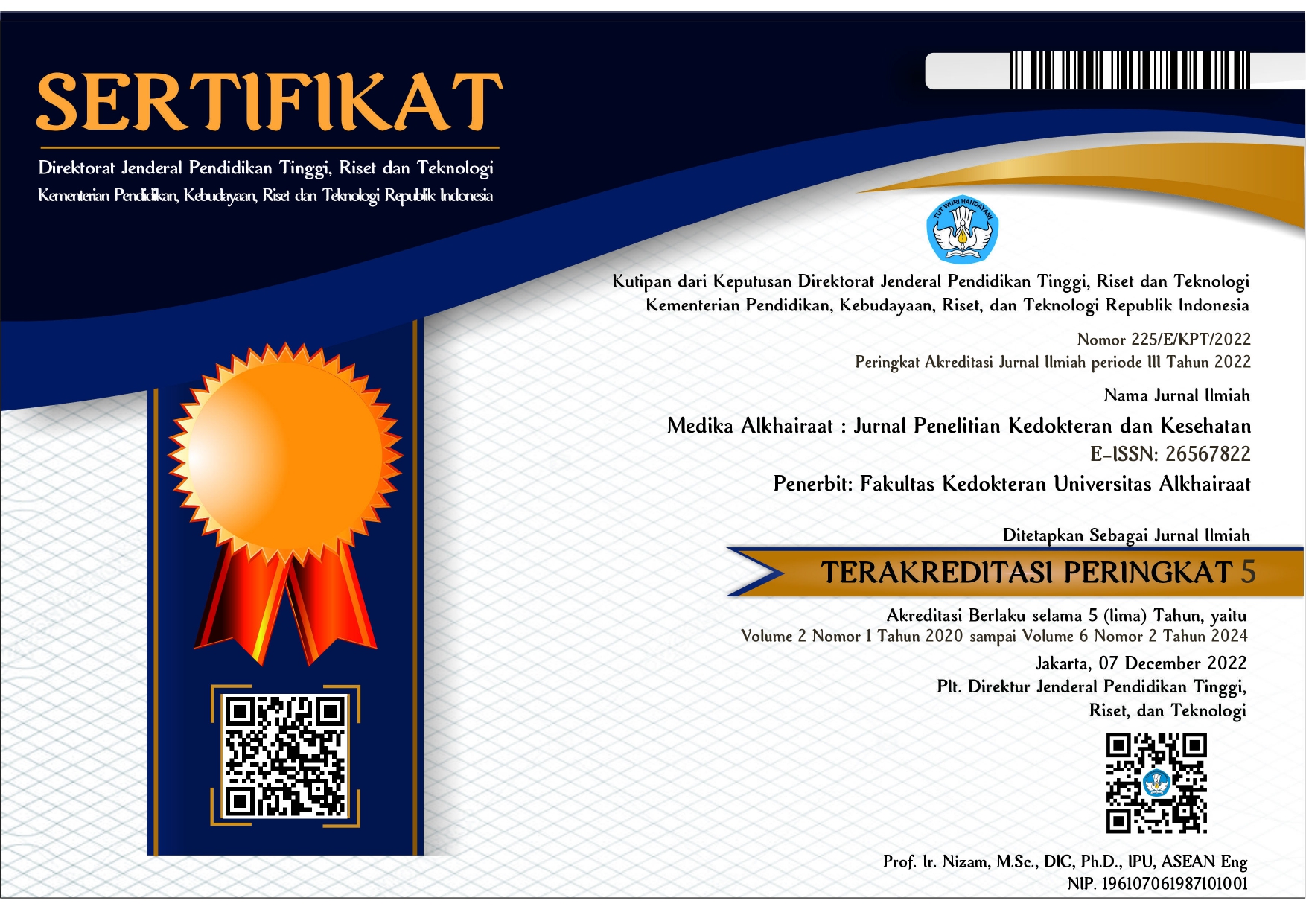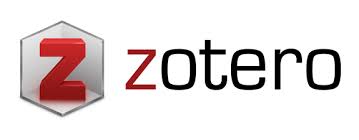PENGARUH INTERVENSI REPETITIVE TRANSCRANIAL MAGNETIC STIMULATION TERHADAP FUNGSI SENSORIMOTOR PADA PASIEN STROKE ISKEMIK SUBAKUT
Abstract
Stroke adalah gangguan akut perfusi serebral dan penyebab kecacatan pada populasi di seluruh dunia. Stroke iskemik subakut adalah fase stroke berdasarkan waktu pemulihan. Untuk mengatasi permasalahan fungsi sensorimotor akibat stroke diperlukan neurorestorasi. Strategi baru dalam bidang neurorestorasi berupa neuroinvasive brain stimulation (NIBS), salah satu modalitasnya adalah repetitive transcranial magnetic stimulation (rTMS). Penelitian sebelumnya menunjukkan bahwa rTMS telah menunjukan berbagai manfaat terhadap perbaikan fungsi sensorimotor pasca stroke, namun, masih terdapat hasil yang bervariasi. Penelitian ini merupakan jenis penelitian eksperimental dengan desain pre-test post-test control group. Data demografi serta tanda dan gejala pasien diperoleh dari anamnesis dan pemeriksaan fisik. Protokol rTMS menggunakan stimulus eksitasi frekuensi 10 Hz, 740 pulse selama 7 menit 10 detik dan stimulus inhibisi frekuensi 1 Hz, 1200 pulse selama 19 menit 59 detik sedangkan penilaian terhadap fungsi sensorimotor menggunakan skor fugl-mayer assesment upper extremity dan lower extremity (FMA-UE dan FMA-LE) sebelum dan setelah perlakuan. Uji Wilcoxon dan uji Mann Whitney dilakukan untuk analisis statistik. Signifikansi statistik didefinisikan sebagai nilai p <0,05. Terdapat pengaruh intervensi repetitive Transcranial Magnetic Stimulation terhadap fungsi motorik dimana fungsi motorik pada UE perlakuan (16,33±8,61) dan UE kontrol (2,80±1,42), nilai p 0,000*.
Downloads
References
Khaku AS, Tadi P. Cerebrovascular Disease. [Updated 2023 Aug 7]. In: StatPearls [Internet]. Treasure Island (FL): StatPearls Publishing; 2023 Jan-. Available from: https://www.ncbi.nlm.nih.gov/books/NBK430927/
Fan J, et al (2023). Global Burden, Risk Factor Analydid, and Prediction Study of Ischemic Stroke, 1990-2030. Neurology 2023;101(2) e137-e150. Available at: https://doi.org/10.1212/WNL.0000000000207387
Kwakkel G, Veerbeek JM, van Wegen EE, Wolf SL. Constraint-induced movement therapy after stroke. Lancet Neurol. 2015 Feb;14(2):224-34. doi: 10.1016/S1474-4422(14)70160-7. PMID: 25772900; PMCID: PMC4361809..
Bernhardt, J et al. 2017. Agreed definitions and a shared vision for new standards in stroke recovery research: The Stroke Recovery and Rehabilitation Roundtable taskforce. International Journal of Stroke 12, 444–450. https://doi.org/10.1177/1747493017711816
Kuthiala N et al. 2020. rTMS and CIMT for Neurofunctional Recovery in Chronic Stroke. Int J Neurorehabil, 7(6), 10-37421. Available at: https://DOI: 10.37421/ijn.2020.7.378.
Wang D et al. 2022. The Mechanism and Clinical Application of Constraint-Induced Movement Therapy in Stroke Rehabilitation. Front Behav Neurosci. https://doi:10.3389/fnbeh.2022.828599.
Dionísio, A. et al. (2018). The Use of Repetitive Transcranial Magnetic Stimulation for Stroke Rehabilitation: A Systematic Review’, Journal of Stroke and Cerebrovascular Diseases, 27(1), pp. 1–31. Available at: https://doi.org/10.1016/j.jstrokecerebrovasdis.2017.09.008.
Fisicaro, F. et al. (2019) ‘Repetitive transcranial magnetic stimulation in stroke rehabilitation: review of the current evidence and pitfalls’, Therapeutic Advances in Neurological Disorders, 12, p. 175628641987831. Available at: https://doi.org/10.1177/1756286419878317.
Pusat Data dan Informasi Kementrian Kesehatan RI. (2019). Infodatin Stroke 2019. Kementrian Kesehatan Republik Indonesia. 1-10.
Pellegrino L, et al. 2021. Effects of Hemispheric Stroke Localization on the Reorganization of Arm Movements within Different Mechanical Environments. Life, 11(5). Available from: https://doi.org/10.3390/life11050383
Akbar, M, et al. 2018. Clinical features of transient ischemic attack or ischemic stroke patients at high recurrence risk in Indonesia. Neurology Asia 23, 107–113.
Ni J, et al. (2023) Effect of rTMS intervention on upper limb motor function after stroke: A study based on fNIRS. Front. Aging Neurosci. 14:1077218. Available from: https://doi:10.3389/fnagi.2022.1077218
Kim JS et al. 2019. Effect of Repetitive Transcranial Magnetic Stimulation in Post Stroke Patients with Severe Upper Limb Motor Impairment. Brain Neurorehabil. 2020 Mar;13(1):e3 Available from: https://doi.org/10.12786/bn.2020.13.e3
Yoon JA et al. 2014. Effect of Constraint Induced Movement Therapy and Mirror Therapy for Patients With Subacute Stroke. Ann Rehabil Med 2014;38(4):458-466. Available from: http://dx.doi.org/10.5535/arm.2014.38.4.458
Copyright (c) 2024 Medika Alkhairaat : Jurnal Penelitian Kedokteran dan Kesehatan

This work is licensed under a Creative Commons Attribution 4.0 International License.
Authors who publish with Medika Alkhairaat : Jurnal Penelitian Kedokteran dan Kesehatan agree to the following terms:
1. Authors retain copyright and grant Journal Medika Alkhairaat right of first publication with the work simultaneously licensed under a Creative Commons Attribution-NonCommercial License (http://creativecommons.org/licenses/by-nc/4.0/) that allows others to remix, adapt, build upon the work non-commercially with an acknowledgement of the work’s authorship and initial publication in Journal Medika Alkhairaat.
2. Authors are permitted to copy and redistribute the journal’s published version of the work non-commercially (e.g., post it to an institutional repository or publish it in a book), with an acknowledgement of its initial publication in Journal Medika Alkhairaat.








